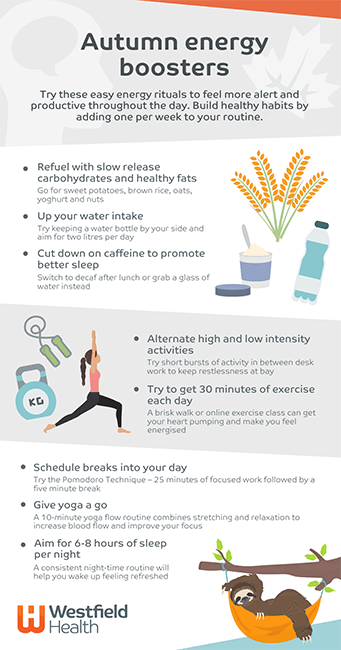As winter approaches and temperatures start to drop, the workforce enters its annual slump. For many, the day-to-day uncertainty of the coronavirus pandemic will make this year especially draining.
With the nights drawing in and the festive season approaching, it can feel like there’s just not enough time to fit everything in. We’ve all had days where we’ve worked non-stop, yet by the end we seem to have achieved very little. We become tempted to work through our lunch breaks or sacrifice an hour of sleep to buy a bit more time in the day. Perhaps it’s not more time that we need, but more energy. An energised team makes the most of the working day, without risking burnout.
An energy balancing act
Throughout the day our energy levels fluctuate as we fuel our bodies and use that energy. Our bodies burn over 1000 calories each day just processing our vital functions, before we even consider exercise, mental fatigue or stressful deadlines. For many people, the changing seasons can further exacerbate these energy shifts. Try our free Beat the Winter Blues guides for more detailed winter health tips.
Think about how your daily activities build or deplete your energy. A large meal can fuel us with energy or make us feel sluggish. An intense workout can be invigorating or exhausting, depending on how well we have prepared our bodies. The key is to balance activities to maintain energy levels throughout the day.
The same applies in the workplace. Employee energy is influenced by dozens of factors throughout the day. Bear in mind the four pillars of performance: mindset, nutrition, movement and recovery. It’s likely that most of us can identity a deficiency in at least one of these categories.
Encourage your team to proactively think about how they manage their energy and create proactive energy habits. Whether it’s eating a healthy breakfast, building better sleep habits or scheduling a five-minute workout, small changes can reinvigorate the workforce.
Embracing the ebb and flow
Many of us struggle to boost our energy when we need it the most. In high pressure situations it can feel like we don’t have time to eat and rehydrate, nevermind stop to relax. A hard worker may appear to have lots of energy. How else would they be getting so much done? But without proper energy management, long stints of tiring work will lead to burnout. By the time we stop to recognise the mounting signs of fatigue, it’s often too late for quick fixes.
If we can foster habits that maintain employee energy levels, teams will be well equipped to take stressful days in their stride. Productivity is not about working flat out all the time. It’s important to build a schedule that includes time to recharge. Try introducing the Pomodoro Technique to boost productivity and encourage balance by scheduling periods of focus and planned recovery.
Before a big competition, athletes taper their training and prioritise rest. In the same way, we must manage energy levels at work to perform at our best when it matters most. If healthy habits can be ingrained in the wider workforce, teams will benefit from a more stable working culture.
Energy boosting tips for managers
While most people experience periods of high pressure, employees shouldn’t regularly feel drained. Managers must lead by example and build positive habits for their team to follow. During the workday, be open about taking regular breaks and encourage others to do the same. Schedule time during meetings for people to pause and regroup.
If an employee is struggling with low energy, it may be common for someone else to pick up the slack. This not only masks the true problem, but also depletes the energy of the wider team. Be aware of the signs that your team is overreaching. Can you recognise when your team is fatigued and step in before they become exhausted?
An employee experiencing low energy is likely to feel less productive and become frustrated with their work, so schedule time to discuss energy levels in catch ups and 1:1s. Keep in mind that energy is influenced by factors both in and outside the workplace. While these factors are sometimes out of our control, taking action throughout the day can steer us in the right direction.
Resources for your team
Low energy is usually caused by just one or two main factors, such as lack of sleep or nutrition, but often only small changes are needed to make a real difference. Encourage employees to recognise which energy boosting habits they already practise and keep doing them. From there, gradually introduce new goals. It could be as simple as switching to decaf or stretching twice a day. Building new habits slowly helps them to stick. Try sharing these easy energy rituals with your team, or download the file as a PDF.
